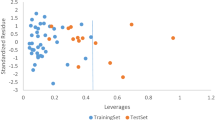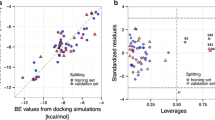Abstract
Nitroaromatics are typical toxic organic pollutants and are ubiquitous in environment with diverse structures. They are widely used in many industries and formed during many natural and anthropogenic processes. Most of these pollutants are potentially carcinogenic and the assessment and prediction of the mutagenicity of nitroaromatics are of great interest. In this paper the structure-mutagenicity relationships of 219 nitroaromatics are investigated by molecular orbital theory based classic structure-activity relationships and comparative molecular field analysis (CoMFA). A comparison is undertaken in respect of the interpretation of mechanism and predictive ability for these two categories of QSAR approaches and highly predictive QSAR models have been developed.
Similar content being viewed by others
References
Wang, L. S., Quantitative Structure-Activity Relationships of Organic Pollutants (in Chinese), Beijing: Environmental Science Press of China, 1993.
Wang, X. D., Structure-activity Relationships of Selected Organic Pollutants (in Chinese), Nanjing: Doctoral Thesis of Nanjing University, 2002.
Hadley, W. M., A review of the literature on enzymatic reduction of nitrocompounds, Springfield: LMF-104 UC 48 National Tech. Inform. Serv., U.S. Department of Commerce, 1983, 1 -20.
Rosenkranz, H. S., Mermelstein, R., The genotoxicity, metabolism and carcinogenicity of nitrated polycyclic aromatic hydrocarbons, J. Environ. Sci. Health., 1985, C3: 221–272.
Fu, P. P., Metabolism of nitro-PAHs, Drug Metab. Rev., 1990, 22: 209–268.
Maro, D. M., Ames, B. N., Revised methods for the S. typhi- murium mutagenicity test, Mut. Res., 1983, 113: 173 - 215.
Zeiger, E., Carcinogenicity of mutagens: Predictive capability of the Salmonella mutagenesis assay for rodent carcinogenicity, Cancer Res., 1987, 47: 1287–1296.
Flansch, C., Leo, A., Hoekman, D., Exploring QSAR. Hydrophobic, Electronic, and Steric Constants, Washington, D. C: American Chemical Society, 1995, 219–304.
Zeiger, E., Ashby, J., Bakale, G. et al., Prediction of Salmonella mutagenicity, Mutagenesis, 1996, 11: 471–484.
Rosenkranz, H. S., Klopman, G., The structural basis of the mutagenicity of chemicals in Salmonlla typhimurium: The national Toxicology Program Database, Mut. Res., 1990, 228: 51 -80.
Cramer III, R. D., Patterson, D. E., Bunce, J. D., Comparative molecular field analysis (CoMFA), Effect of shape on binding of steroids to carrier proteins, J. Am. Chem. Soc., 1989, 110: 5959–5967.
Waller, C. L., McKinney, J. D., Three-dimensional quantitative structure-Activity relationships of dioxins and dioxin-like compounds: Model validation and Ah receptor characterization, Chem. Res. Toxicol., 1995, 8: 847–858.
Debnath, A. K., Lopez de Compadre, R. L., Debnath, G. et al., Structure-activity relationships of mutagenic aromatic heteroaro- matic nitro compounds. Correlation with molecular orbital energies and hydrophobicity, J. Med. Chem., 1991, 34: 786–797.
Fu, P. P., Ni, Y., Zhang, Y. et al., Effect of orientations of nitro substituent on the bacterial mutagenicity of dinitrobenzo[e]pyrenes, Mut. Res., 1989, 225: 121–125.
You, Z., Brezzell, M. D., Das, S. K. et al., Ortho substituent effects on the in vitro and in vivo genotoxicity of benzidine derivatives, Mut. Res., 1993, 319: 19–30.
Hooberman, B. H., Brezzell, M. D., Das, S. K. et al., Substituent effects on the genotoxicity of 4-nitrostilbene derivatives, Mut. Res., 1994, 341: 57–69.
Watanabe, M., Nohmi, T., Ishidate, M. Jr., New tester strains of Salmonella typhimurium highly sensitive to mutagenic nitroarenes, Biochem. Biophys. Res. Commun., 1987, 147: 974–979.
McFarland, J. W., On the parabolic relationship between drug potency and hydrophobicity, J. Med. Chem., 1970, 13: 1092–1196.
Basak, S. C., Grunwald, G. D., Predicting mutagenicity of chemicals using topological and quantum chemicals parameters: A similarity based study, Chemosphere, 1995, 31: 2529- 2546.
Toropov, A. A., Toropova, A. P., Prediction of heteroaromatic amine mutagenicity by means of correlation weighting of atomic orbital graphs of local invariants, J. Mol. Struct. (Theochem)., 2001, 538: 287–293.
Author information
Authors and Affiliations
Corresponding author
Rights and permissions
About this article
Cite this article
Wang, X., Lin, Z., Yin, D. et al. 2D/3D-QSAR comparative study on mutagenicity of nitroaromatics. Sc. China Ser. B-Chem. 48, 246–252 (2005). https://doi.org/10.1360/04yb0077
Received:
Issue Date:
DOI: https://doi.org/10.1360/04yb0077




